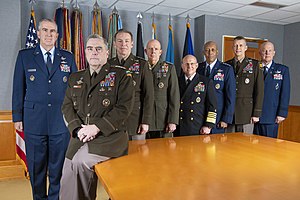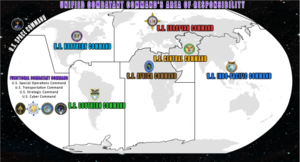
A | B | C | D | E | F | G | H | CH | I | J | K | L | M | N | O | P | Q | R | S | T | U | V | W | X | Y | Z | 0 | 1 | 2 | 3 | 4 | 5 | 6 | 7 | 8 | 9
This article needs to be updated. The reason given is: See Personnel Section. (June 2024) |
The United States Armed Forces are the military forces of the United States.[13] The armed forces consist of six service branches: the Army, Marine Corps, Navy, Air Force, Space Force, and Coast Guard.[14][15] All six armed services are among the eight uniformed services of the United States.[16]
Each of the different military services is assigned a role and domain. The Army conducts land operations. The Navy and Marine Corps conduct maritime operations, the Marine Corps specializing in amphibious and maritime littoral operations primarily for supporting the Navy. The Air Force conducts air operations. The Space Force conducts space operations. The Coast Guard is unique in that it specializes in maritime operations and is also a law enforcement agency.[17][18]
From their inception during the American Revolutionary War, the U.S. Armed Forces have played a decisive role in the country's history. They helped forge a sense of national unity and identity through victories in the early-19th-century First and Second Barbary Wars. They played a critical role in the territorial evolution of the U.S., including the American Civil War. The National Security Act of 1947 created the modern U.S. military framework, establishing the National Military Establishment (later the Department of Defense or DoD) headed by the secretary of defense and creating both the U.S. Air Force and National Security Council; in 1949, an amendment to the act merged the cabinet-level departments of the Army, Navy, and Air Force into the DoD.[19]
The president of the U.S. is the commander-in-chief of the armed forces and forms military policy with the DoD and Department of Homeland Security (DHS), both federal executive departments, acting as the principal organs by which military policy is carried out.
The U.S. Armed Forces are one of the world's largest military forces in terms of personnel. They draw their personnel from a large pool of professional volunteers. The U.S. has used military conscription, but not since 1973. The Selective Service System retains the power to conscript males, requiring the registration of all male citizens and residents living in the U.S. between the ages of 18 and 25.
The U.S. Armed Forces are considered the world's most powerful military, especially since the end of the Cold War.[20] The military expenditure of the U.S. was US$916 billion in 2023, the highest in the world, accounting for 37% of the world's defense expenditures.[21] The U.S. Armed Forces has significant capabilities in both defense and power projection due to its large budget, resulting in advanced and powerful technologies which enable widespread deployment of the force around the world, including around 800 military bases outside the U.S.[22] The U.S. Air Force is the world's largest air force, followed by the U.S. Army Aviation Branch. The U.S. Naval Air Forces is the fourth-largest air arm in the world and is the largest naval aviation service, while U.S. Marine Corps Aviation is the world's seventh-largest air arm. The U.S. Navy is the world's largest navy by tonnage.[23] The U.S. Coast Guard is the world's 12th-largest maritime force.[24] The U.S. Space Force is the world's only active independent space force.[25]
History
The history of the U.S. Armed Forces dates back to 14 June 1775, with the creation of the Continental Army, even before the Declaration of Independence marked the establishment of the United States.[26] The Continental Navy, established on 13 October 1775, and Continental Marines, established on 10 November 1775, were created in close succession by the Second Continental Congress in order to defend the new nation against the British Empire in the American Revolutionary War.[27][28]
These forces demobilized in 1784 after the Treaty of Paris ended the Revolutionary War. The Congress of the Confederation created the current United States Army on 3 June 1784.[26] The United States Congress created the current United States Navy on 27 March 1794 and the current United States Marine Corps on 11 July 1798.[27][29] All three services trace their origins to their respective Continental predecessors. The 1787 adoption of the Constitution gave Congress the power to "raise and support armies," to "provide and maintain a navy," and to "make rules for the government and regulation of the land and naval forces," as well as the power to declare war. The President of the United States is the U.S. Armed Forces' commander-in-chief.[30]
The United States Coast Guard traces its origin to the formation of the Revenue Cutter Service on 4 August 1790, which merged with the United States Life-Saving Service on 28 January 1915 to establish the Coast Guard.[31][32] The United States Air Force was established as an independent service on 18 September 1947; it traces its origin to the formation of the Aeronautical Division, U.S. Signal Corps, which was formed 1 August 1907 and was part of the Army Air Forces before being recognized as an independent service in the National Security Act of 1947.[33] The United States Public Health Service Commissioned Corps was formerly considered to be a branch of the United States Armed Forces from 29 July 1945 until 3 July 1952, and is now one of the eight uniformed services of the United States.[34]
The United States Space Force was established as an independent service on 20 December 2019. It is the sixth branch of the U.S. military and the first new branch in 72 years.[35] The origin of the Space Force can be traced back to the Air Force Space Command, which was formed 1 September 1982 and was a major command of the United States Air Force.[36]
The U.S. Congressional Research Office annually publishes a List of Notable Deployments of U.S. Military Forces Overseas since 1798.[37]
Structure
Presidential command over the U.S. Armed Forces is established in Article II in the Constitution whereby the president is named as the "Commander in Chief of the Army and Navy of the United States, and of the Militia of the several States, when called into the actual Service of the United States."[38] The United States Armed Forces are split between two cabinet departments, with the Department of Defense serving as the primary cabinet department for military affairs and the Department of Homeland Security responsible for administering the United States Coast Guard.[39]
The military chain of command flows from the President of the United States to the secretary of defense (for services under the Defense Department) or secretary of homeland security (for services under the Department of Homeland Security), ensuring civilian control of the military. Within the Department of Defense, the military departments (Department of the Army, United States Department of the Navy, and Department of the Air Force) are civilian led entities that oversee the coequal military service branches organized within each department. The military departments and services are responsible for organizing, training, and equipping forces, with the actual chain of command flowing through the unified combatant commands.[40]

The Joint Chiefs of Staff, although outside the operational chain of command, is the senior-most military body in the United States Armed Forces. It is led by the chairman of the Joint Chiefs of Staff, who is the military head of the armed forces and principal advisor to the president and secretary of defense on military matters. Their deputy is the vice chairman of the Joint Chiefs of Staff. Other members include the chief of staff of the Army, commandant of the Marine Corps, chief of naval operations, chief of staff of the Air Force, chief of space operations, and the chief of the National Guard Bureau.[41] The commandant of the Coast Guard is not an official member of the Joint Chiefs, but sometimes attends meetings as one of the military service chiefs. The senior enlisted advisor to the chairman is the most senior enlisted member in the United States Armed Forces.[42]
Leadership of the Armed Forces, to include the president of the United States, the secretary of defense, the secretary of Homeland Security and chairman of the Joint Chiefs of Staff are members of the United States National Security Council, which advises the president on national security, military, and foreign policy matters.[43] The national security advisor, the homeland security advisor, and the deputy national security advisor may also be members of the United States Armed Forces.[44][45] The National Security Council Deputies Committee also includes the deputy secretary of defense, deputy secretary of homeland security, and vice chairman of the Joint Chiefs of Staff.[46] Military leadership, including the secretary of defense, the secretary of Homeland Security, and chairman of the Joint Chiefs of Staff also sit on the National Space Council.[47]
Unified combatant commands

Unified combatant commands are joint military commands consisting of forces from multiple military departments, with their chain of command flowing from the president, to the secretary of defense, to the commanders of the combatant commands. Each service organizes, trains, and equips forces that are then presented to the unified combatant commands through service component commands. Special Operations Command and Cyber Command also present theater special operations commands or joint force headquarters – cyber to other combatant commanders. Army components are typically dual-hatted as the joint force land component, Navy components are typically dual-hatted as the joint force maritime component, and Air Force components are typically dual-hatted as the joint force air component, with the theater special operations command dual-hatted as the joint force special operations component, and Space Force component typically dual-hatted as the joint force space component.[48]
| Name | Mission | Headquarters | Subunified commands | |
|---|---|---|---|---|

|
U.S. Africa Command (USAFRICOM) | Conducts U.S. military operations in Africa. | Kelley Barracks, Germany | |

|
U.S. Central Command (USCENTCOM) | Conducts U.S. military operations in the Middle East and Central Asia. | MacDill Air Force Base, Florida | |

|
U.S. Cyber Command (USCYBERCOM) | Conduct U.S. military cyber operations. | Fort Meade, Maryland | |

|
U.S. European Command (USEUCOM) | Conducts U.S. military operations in Europe. | Patch Barracks, Germany | |

|
U.S. Indo-Pacific Command (USINDOPACOM) | Conducts U.S. military operations in the Indo-Pacific. | Camp H. M. Smith, Hawaii | |

|
U.S. Northern Command (USNORTHCOM) | Conducts U.S. military operations in North America and homeland defense operations. | Peterson Space Force Base, Colorado | |

|
U.S. Southern Command (USSOUTHCOM) | Conducts U.S. military operations in Central America, South America, and the Caribbean. | Doral, Florida | |

|
U.S. Space Command (USSPACECOM) | Conducts U.S. military operations in outer space. | Peterson Space Force Base, Colorado | |

|
U.S. Special Operations Command (USSOCOM) | Develops and employs special operations forces. | MacDill Air Force Base, Florida | |
 Zdroj:https://en.wikipedia.org?pojem=US_military
Zdroj:https://en.wikipedia.org?pojem=US_militaryText je dostupný za podmienok Creative Commons Attribution/Share-Alike License 3.0 Unported; prípadne za ďalších podmienok. Podrobnejšie informácie nájdete na stránke Podmienky použitia.
Analytika
Antropológia Aplikované vedy Bibliometria Dejiny vedy Encyklopédie Filozofia vedy Forenzné vedy Humanitné vedy Knižničná veda Kryogenika Kryptológia Kulturológia Literárna veda Medzidisciplinárne oblasti Metódy kvantitatívnej analýzy Metavedy Metodika Text je dostupný za podmienok Creative
Commons Attribution/Share-Alike License 3.0 Unported; prípadne za ďalších
podmienok. www.astronomia.sk | www.biologia.sk | www.botanika.sk | www.dejiny.sk | www.economy.sk | www.elektrotechnika.sk | www.estetika.sk | www.farmakologia.sk | www.filozofia.sk | Fyzika | www.futurologia.sk | www.genetika.sk | www.chemia.sk | www.lingvistika.sk | www.politologia.sk | www.psychologia.sk | www.sexuologia.sk | www.sociologia.sk | www.veda.sk I www.zoologia.sk | ||||






